The effect of different high pressure die casting parameters on 3D microstructure and mechanical properties of AE44 magnesium alloy
2023-12-27TongtongZhngWenYuChoshengWntongChenLinZhngShoumeiXiong
Tong-tong Zhng ,Wen-o Yu,* ,Cho-sheng M ,Wn-tong Chen ,Lin Zhng ,Shou-mei Xiong
a Center of Materials Science and Engineering, School of Mechanical and Electronic Control Engineering, Beijing Jiaotong University, Beijing 100044,China
b China Academy of Machinery Science and Technology Group Co., Ltd, Beijing 100044, China
cSchool of Materials Science and Engineering, Tsinghua University, Beijing 100084, China
Abstract To understand the relationship between the process-microstructure-mechanical properties of the high-pressure die-casting (HPDC) AE44 magnesium alloy,3D reconstruction and 2D characterization were carried out on the HPDC castings produced with different process parameters(low slow-shot speed,fast slow-shot speed,solidification pressure).Microstructural characterization revealed that the formation of shrinkage pores are closely related to ESCs,which were mainly controlled by the low slow-shot speed in shot sleeve (ESCs growth time) and fast slow-shot speed into the die cavity (distribution of ESCs).In addition,solidification pressure can significantly reduce the shrinkage porosity in the center by improving the feeding capacity of liquid metal.Tensile fracture revealed that the tearing ridge is mainly evolved from the slip band of ESCs.The quantity and distribution of ESCs determine the fracture mode of castings.The relationship between mechanical properties of castings and the morphology of ESCs and porosity is also statistically discussed.
Keywords: HPDC parameters;Porosity;Externally solidified crystals (ESCs);Tensile fracture;3D reconstruction.
1.Introduction
Grace to its advantages of high forming accuracy,significant efficiency and few post-processing requirements,high pressure die casting (HPDC) is the first choice for producing magnesium alloy castings [1–3].As HPDC process contains relatively high shot speeds and high interfacial heat transfer coefficient between the melt and die,the defects,such as porosity (gas pores and shrinkage),large dendritic and Externally Solidified Crystals (ESCs) forms in castings [4–6].
In order to reduce or even eliminate these defects,huge work has been carried out to investigate the formation mechanism of the defects and their influence on the mechanical performance of castings.The size of ESCs in shot sleeve is inversely related with the shot speed and their accumulation can introduce the shrinkage pores [7,8].Because of the interlaced voids between ESCs dendrites,the insufficient feeding of molten metal during solidification process arouses the formation of complex and interconnected porosity in the castings.Sometimes,the agglomeration of ESCs leads to the formation of large-scale defect bands [9,10].Yu et al.[11]reported that the defect bandwidth is strongly related to the size and quantity of ESCs in AZ91D castings.These defects seriously deteriorate the mechanical properties of castings.Biswas et al.[12]reported that the strength and elongation of the HPDC AZ91 magnesium alloy were related to the porosity volume fraction.Li et al.[13–15]confirmed that the airshrinkage pores and net-shrinkage pores are the origin of the crack and facilitate the crack propagation under the in-situ tensile test.
The mechanical performance of HPDCed castings can be optimized by the reduction of ESCs size and quantity.For example,the low slow-shot speed can reduce the growth time of ESCs in shot sleeve,while the acceleration of plunger reduces the vacuum time and arouses the air entrapment [16–18].The shear stress could break or remelt large inclusions and ESCs when the semisolid melt passed through the gating system at the fast slow-shot speeds [19,20].The intensification pressure significantly reduced the porosity amount by reducing gas porosity [21].Wang et al.[22]found that the vacuum pressure in the die cavity at the beginning of mold filling was significantly reduced by using three-step slow shot speed.
Due to the low density and excellent high-temperature mechanical properties,AE44 (Mg-4Al-4RE-0.4Mn) magnesium alloy has been developed for the application in automotive field at elevated temperature.In our previous study [23]we only compared the difference of HPDC AE44 castings obtained with/without fast slow-shot speed and with/without casting pressurization).It was found that the shrinkage porosities generally coexist with Externally Solidified Crystals(ESCs).However,the optimization of different process parameters on the microstructure and mechanical properties of HPDC AE44 magnesium alloy has not yet been systematically investigated.Herein,we designed the HPDC processes by modifying the parameters,including low slow-shot speed,fast slow-shot speed and casting pressure.Then,3D reconstruction was conducted for building the correlation between mechanical properties and microstructure of castings.
2.Experiments
In this work,AE44 magnesium alloy was selected and cast by a TOYO-BD-350V5 cold chamber die-casting machine under vacuum condition.The chemical composition of AE44 magnesium alloy is shown in Table 1.Fig.1(a) shows the schematic of the experimental setup of the shot sleeve.The entire length and diameter of shot sleeve are 340 mm and 40 mm.The melting temperature and initial mold temperature were set to be 700°C and 150°C.During the casting process,the plunger was moved from 40 to 270 mm at a low slowshoot speed,and then accelerated with a fast slow-shot speed from 270 to 285 mm and then push the melt into the mold cavity.After filling,the liquid metal is solidified and shaped under high pressure,and the casting is finally taken out.More details about three HPDC processes were summarized in Table 2.
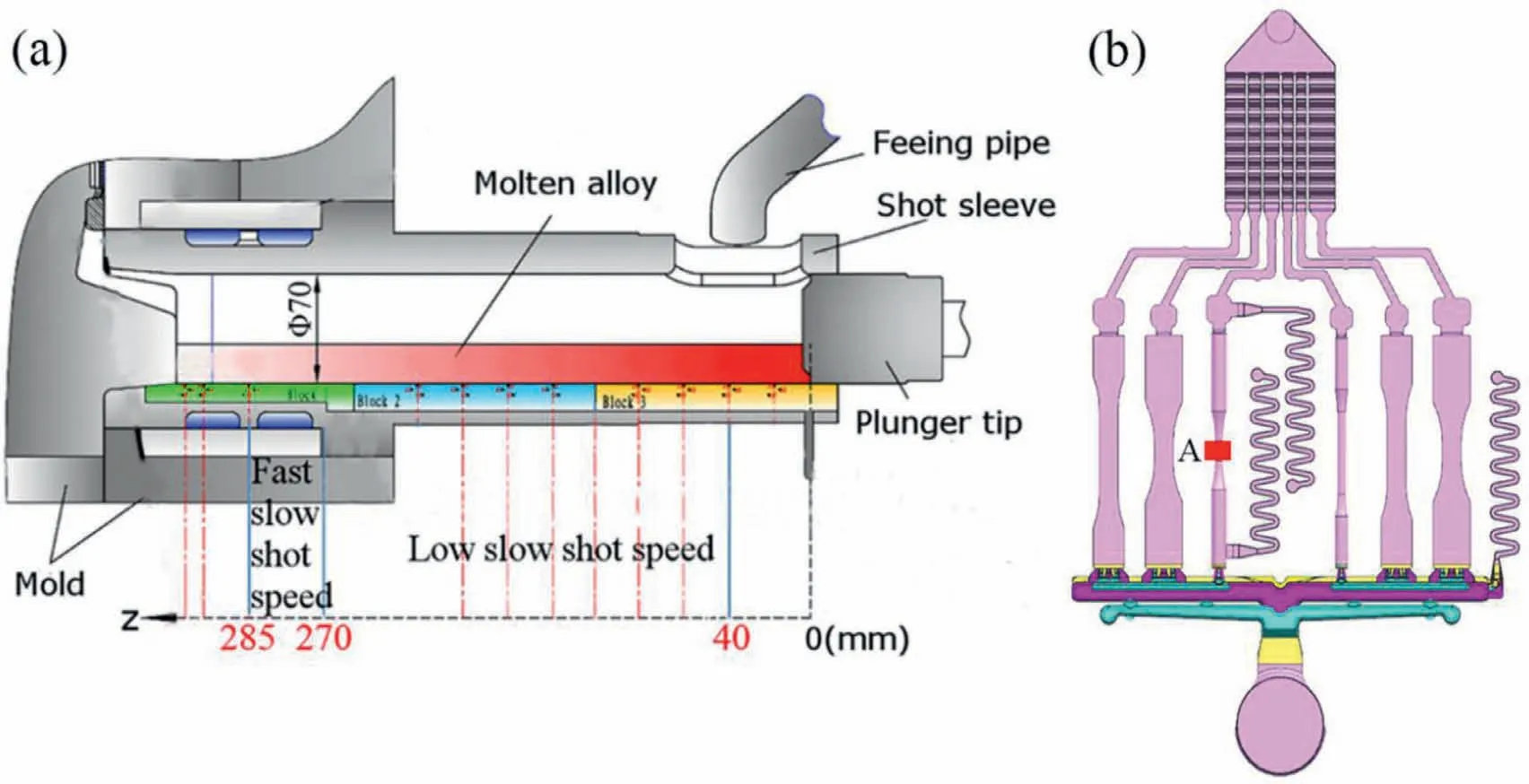
Fig.1.(a) Schematic of experimental setup of the shot sleeve,length unit is mm,(b) the configuration of the casting.

Table 1The chemical composition of AE44 magnesium alloy (weight%).

Table 2Key parameters of the seven designed HPDC processes.
The specimens used for scanning electron microscope(SEM) observation were taken at A location marked in Fig.1(b).In order to reconstruct 3D morphology of porosity defects,the synchrotron X-ray micro-tomography experiment was carried out at the BL13W1 line station of the Shanghai Synchrotron Radiation Facility (SSRF).The X-ray energy of the synchrotron was 30 Kev beamline.For converting the Xrays to visible light,a YAG: Ge scintillator screen equipped with a 2048×2048 pixels camera was adopted.Then use the inverse filter projection algorithm with software PITRE to reconstruct the 2D projection into 3D volume.Finally,Avizo software was used to process the reconstructed data.
Tensile tests were performed on a WDW-3020 electron universal testing machine at room temperature (25°C) with a displacement speed of 1 mm/min.21 tensile specimens were used to evaluate the mechanical properties (it carried three tensile tests out on the samples of each die casting process),including yield strength,ultimate tensile strength and elongation.
3.Results
Fig.2(a) shows the typical microstructure of HPDC-AE44 magnesium alloy castings under the conventional processes.The morphology is composed of small round shapeα-Mg grains,large dendritic externally solidified crystals (ESCs)and porosity (gas pores and shrinkage).Two main rare earth phases were found in AE44 magnesium alloy.Al2RE phase characterized with bright white granular morphology and dispersed inα-Mg grains,while Al11RE3phase is characterized with a gray-white flocculent morphology and mainly distributed atα-Mg grain boundaries [24,25].The 3D porosity morphology of HPDC AE44 alloy obtained via 3D reconstruction is shown in Fig.2 (b-f).According to the previous report [13],the porosity can be divided into four categories in reference to the different formation mechanism and morphology (volume size and sphericity),including gas pore (small size and round shape),gas-shrinkage pore (relatively large size and complex morphology),net-shrinkage (large size and complex morphology) and island-shrinkage (small size and relatively complicated morphology).

Fig.2.(a) Backscattered scanning image of HPDC AE44 casting,(b) 3D characterization of porosity in HPDC casting,(c) gas-pore,(d) gas-shrinkage pore,(e)net-shrinkage,and (f) island-shrinkage.
Fig.3 shows the microstructure of surface layer,transition area and center zone in rod-shaped specimens produced with different low slow-shot speeds.From the surface to the center zone,as shown in Fig.3 (a1-a3),(b1-b3) and (c1-c3),the size and quantity of ESCs became much less with the increasing low slow-shot speed.The corresponding area percentage and grain size of ESCs were statistically calculated and given in Fig.9 (a1-b1).The area fraction and average size of ESCs increased linearly from the surface to the center in three castings.When the low slow-shot speed was accelerated from 0.1 m/s to be 0.2 m/s,the area percentage and average size of ESCs decreased about 12% and 32 μm respectively.This indicates that low slow-shot speed has a significant effect on the size and morphology of ESCs.
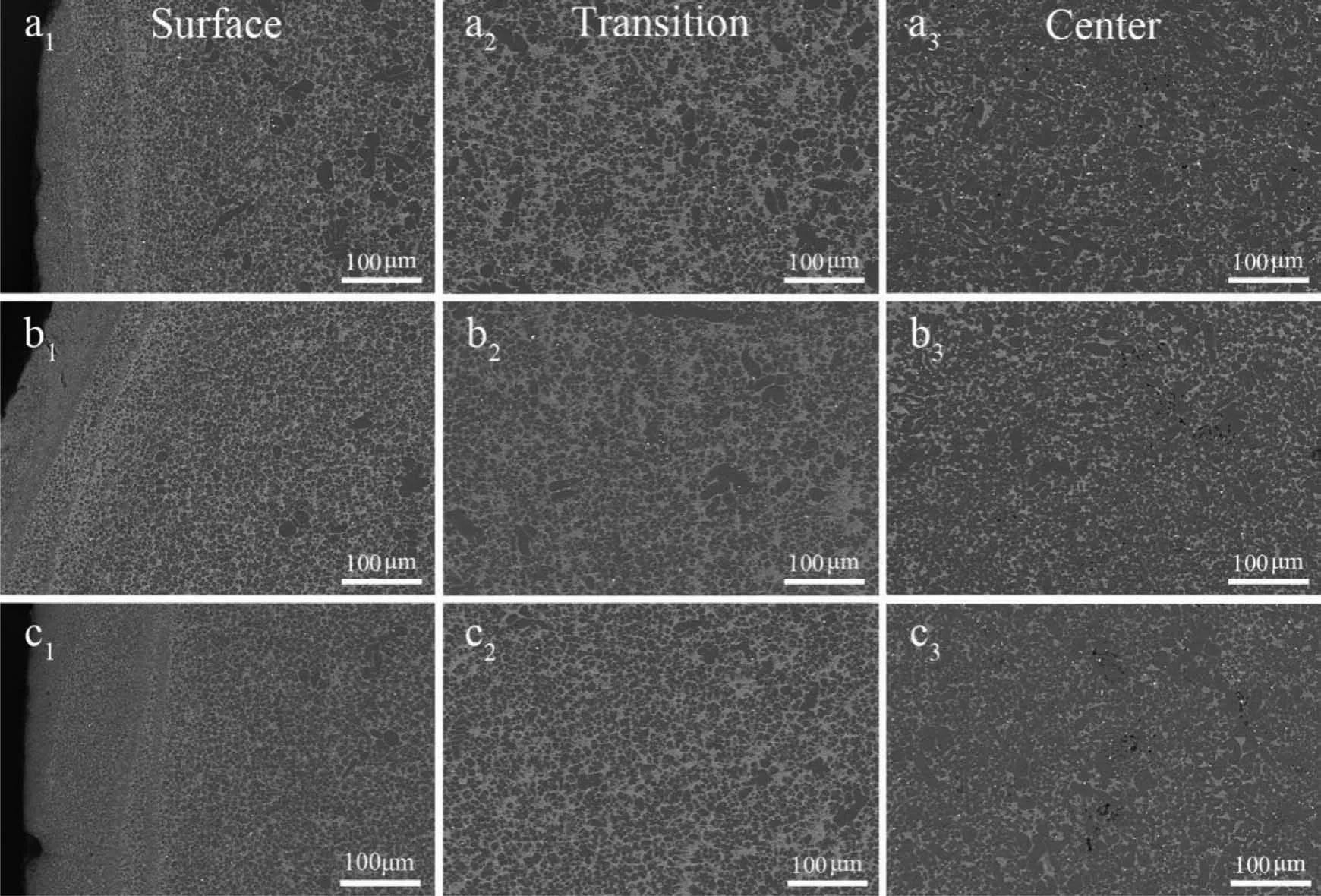
Fig.3.The microstructure of rod-shaped specimens produced at different low slow-shot speeds: (a1-a3) A01–0.1 m/s,(b1-b3) A02–0.15 m/s,(c1-c3) A03–0.2 m/s.

Fig.4.3D reconstruction of the porosity in the center of the rod-shaped specimen at three low slow-shot speed processes: (a1-a4) A01–0.1 m/s,(b1-b4) A02–0.15 m/s,(c1-c4) A03–0.2 m/s.The size of the specimen is 2.1 mm in height and 6.4 mm in diameter.The size of the porosity diameter: red (d<81.25 μm),yellow (d<162.5 μm),green (d<243.75 μm),blue (d<325 μm),purple (d>325 μm).
Fig.4 presents the 3D distribution and morphology of porosity in HPDC castings fabricated with three low slowshot speed processes.The second,third and fourth columns are the enlarged views of the I,II and III areas marked in the first column.At the low show-shot speed of 0.1 m/s,as shown in Fig.4 (a1-a4),the porosity is mainly composed of large-sized net-shrinkage pores and gas-shrinkage pores.With the increasing low slow-shot speed,as found in Fig.4(b1-b4)and Fig.4(c1-c4),the porosity is mainly composed of small gas-pores and island-shrinkage pores.In addition,the volume of porosity is calculated at different positions and given in Fig.9(c1).The porosity volume is significantly reduced with the increasing low slow-shot speed.This trend is well consistent with the trend of the area percentage and average size of ESCs.Similar to our previous report [11],this result further proves that size and morphology of shrinkage pores are closely related to the ESCs.
Fig.5 shows the microstructure of surface layer,transition area and center zone in rod-shaped specimens produced with different fast slow-shot speeds.As shown in Fig.5,the size and quantity of ESCs increased from the surface to the center of the specimen.With the increasing fast slow-shot speed,the size and quantity of ESCs on the surface layer of castings increased.In contrast,the size and quantity of ESCs in the center of the casting decreased with the increasing fast slow-shot speed.At the same time,the ESCs tends to be round.The corresponding area percentage and grain size of ESCs were statistically calculated and given in Fig.9 (a2-b2).With the increasing fast slow-shot speed from 1.75 m/s to be 3.75 m/s,the area percentage and average size of ESCs in the center of the sample decreased about 5.6% and 8.1 um,respectively.However,these values of ESCs in the surface layer reversely increased by 5.1% and 24 μm,respectively.This result indicates that the increasing fast slow shot speed is prone to produce a more uniform distribution of ESCs in the specimen.

Fig.5.The microstructure of rod-shaped specimens produced by three different fast slow-shot speeds: (a1-a3) A05–1.75 m/s,(b1-b3) A01–2.75 m/s,(c1-c3)A04–3.75 m/s.
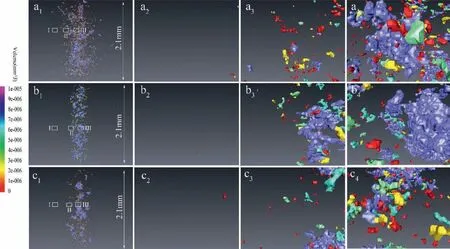
Fig.6.3D reconstruction of the porosity the rod-shaped specimens produced by three fast slow-shot speed processes: (a1-a4) A05–1.75 m/s,(b1-b4) A01–2.75 m/s,(c1-c4) A04–3.75 m/s.The size of the specimen is 2.1 mm in height and 6.4 mm in diameter.The size of the porosity diameter: red (d<81.25 μm),yellow (d<162.5 μm),green (d<243.75 μm),blue (d<325 μm),purple (d>325 μm).
Fig.6 presents the 3D distribution and morphology of porosity in HPDC castings fabricated with three fast slowshot speed processes.The second,third and fourth columns are the enlarged views of the I,II and III areas marked in the first column.As shown in Fig.6 (a3–c3),with the increasing fast slow-shot speed,the morphology of pores became more complex.On the contrary,as shown in Fig.6(a4–c4),with the increasing fast slow-shot speed,the size of the pores in the center gradually decreased and the contiguous shrinkage became gradually less.At the fast slow-shot speed of 3.75 m/s,most of the pores in the center are small gas-shrinkage pores and island-shrinkage.Furthermore,from the statistical results shown in Fig.9(c2),the porosity volume reduced with the increasing fast slow-shot speed,especially the center zone.This result indicates that the reduction of ESCs agglomeration can effectively reduce the volume and quantity of large-size shrinkage pores.
Fig.7 shows the microstructure of surface layer,transition area and center zone in rod-shaped specimens produced with different solidification pressurization.As shown in Fig.7 (a1–c1),the area marked by the white line is the skin layer,which is aroused by the fast interfacial heat transfer coefficient between the molten metal and the mold cavity wall.This chilling effect produces one fine microstructure [26].Yu et al.have carefully investigated the influence of vacuum,speed,casting pressure on interfacial heat transfer coefficient(IHTC) in shot sleeve and die cavity by using AZ91D alloy[7,27].The IHTC peak value is between 6.1 KW·mm-2·K-1and 12.9 KW·mm-2·K-1in the shot sleeve with a cooling rate of 139.9 °C·S-1.Fig.7(a1-c1) shows that the width of the skin layer broadens with the increase of the solidification pressure.This indicates that the solidification pressure can increase the interfacial heat transfer coefficient.In addition,with the increasing solidification pressure,the shape of ESCs tends to be round.In detail,as shown in Fig.9 (a3-b3),with the increasing solidification pressurization,the area percentage and average size of ESCs slightly decreased.This suggests that solidification pressurization has one weak effect on the size and quantity of ESCs.

Fig.7.Morphology of ESCs at the center of rod-shaped specimens at different low slow-shot speeds: (a1-a3) A07–7.8 MPa,(b1-b3) A06–12.5 MPa,(c1-c3)A01–13.7 MPa.
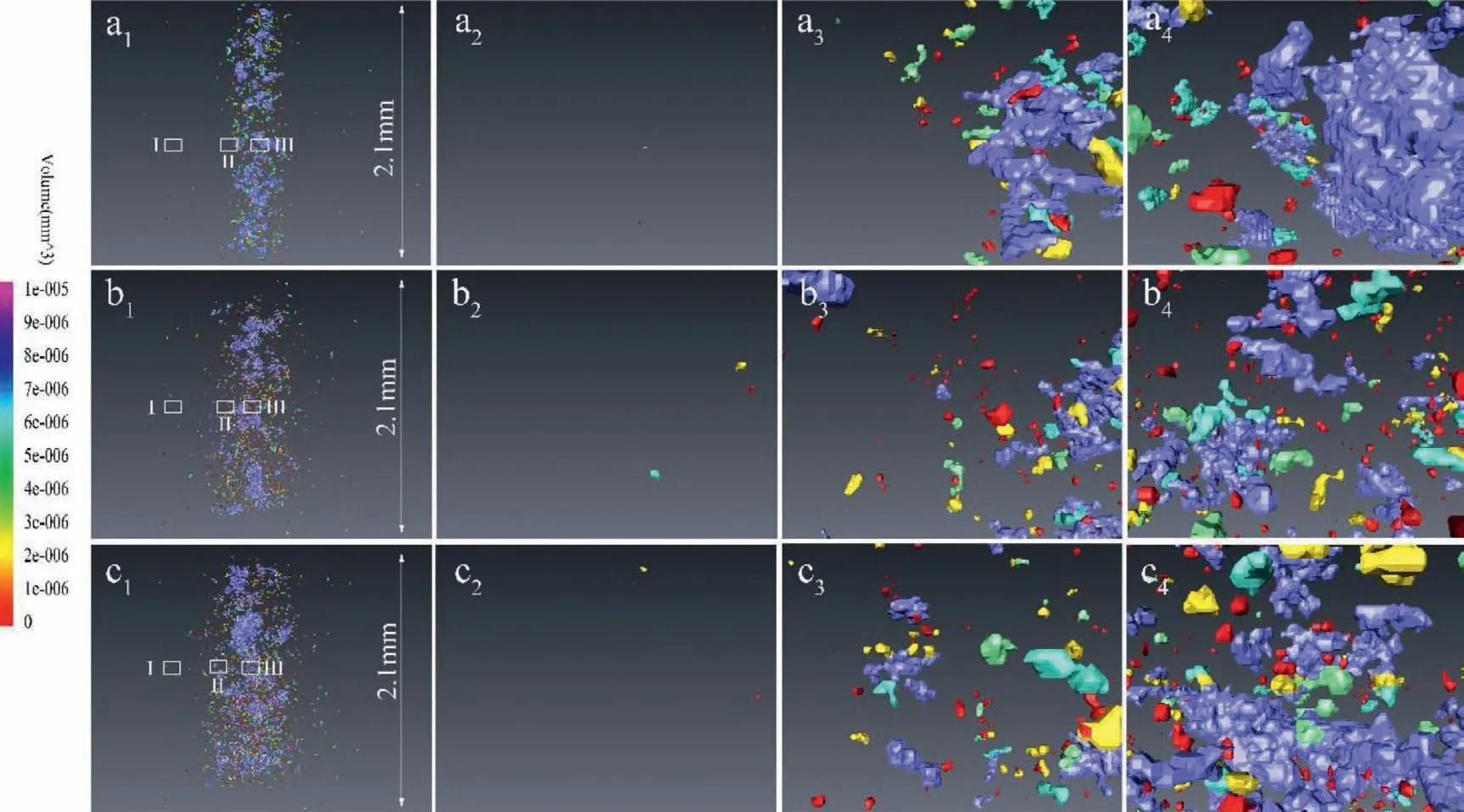
Fig.8.3D reconstruction of the porosity in the center of the rod-shaped specimens fabricated under three solidification pressurization processes: (a1-a3)A07–7.8 MPa,(b1-b3) A06–12.5 MPa,(c1-c3) A01–13.7 MPa.The size of the specimen is 2.1 mm in height and 6.4 mm in diameter.The size of the porosity diameter: red (d<81.25 μm),yellow (d<162.5 μm),green (d<243.75 μm),blue (d<325 μm),purple (d>325 μm).
Fig.8 presents the 3D porosity distribution and morphology of HPDC castings fabricated with three solidification pressurization.The second,third and fourth columns are the enlarged views of the I,II and III areas marked in the first column.Fig.8 (a1-c1)indicates that the porosity is distributed with one spiral staggered shape along the liquid flow direction.With the increasing solidification pressurization,the porosity morphology of continuous spiral staggered line shape disappears.As show in Fig.8 (a4-c4),with the increasing solidification pressurization,the porosity size in the center gradually decreases.In addition,the complex contiguous netshrinkage pores transformed into gas-shrinkage pores.Furthermore,Fig.9(c3) shows that the porosity volume was dramatically reduced by 48% as the solidification pressurization increased from 7.8 MPa to 12.5 MPa.This suggests that the increasing solidification pressurization can significantly reduce the porosity volume.
4.Discussion
Fig.9 shows the statistical results of ESCs area fraction,ESCs average size and porosity volume distribution at different positions of the rod-shaped specimens.As the acceleration of low slow-shot speed reduced the residence time of the molten metal in the shot sleeve,the heat loss of the molten metal and the growth time of ESCs became less in the chamber[28].Due to the reduction of ESCs in size and quantity,as show in Fig.4 and Fig.9(c1),the large-size shrinkage pores and the total porosity volume became less in the rod-shaped specimens.The fast slow-shot speed can enhance the shear stress when the liquid metal enters into the cavity through the sprue,as show in Fig.9 (a2-c2),which could break more ESCs and reduce their size [29].In addition,more rapid fast slow-shot speed could enhance the molten metal turbulence.,which then reduced the agglomeration of ESCs and made ESCs become more uniform.However,the increase of fast slow-shot speed simultaneously aggravated the air entrapment in the cavity,as show in Fig.6,more small-size air pores and gas-shrinkage pores appeared.As the interface heat transfer coefficient can be enhanced by the solidification pressurization between the molten metal and the cavity wall [26],as shown in Fig.8 and Fig.9(a3-b3),the area percentage and average size of ESCs become less with the increasing pressure.At the same time,the increasing solidification pressurization can improve the feeding ability of molten metal,as given in Fig.9(c3),the pore defects became less in the specimen.
Fig.10 presents the quantification of the total porosity volume and average ESC size,UTS,YS and EI of castings fabricated by 7 designed processes.Fig.10 (a-b) presents that the ESCs became strongly less in average diameter and area fraction with the increasing shot speed and solidification pressurization,especially the low slow-shot speed.Fig.10(c) indicates both of increasing shot speed and solidification pressurization can strongly reduce the total porosity volume.Especially,the variation trend of porosity volume is similar to that of average size and fraction of ESCs.This is because the shrinkage pore would form at the ESCs boundaries [30].Similar to the previous reports [12,26],Fig.10 (d-f) indicates that the strength and elongation of castings are inversely proportional to the quantity ESCs and the total porosity volume.
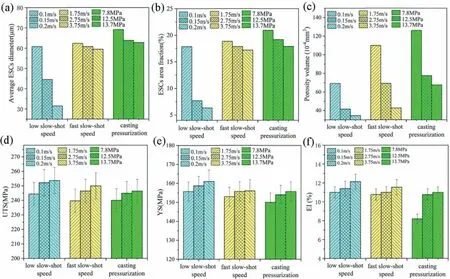
Fig.10.Quantification of the total porosity volume and average ESC size,UTS,YS and EI of castings fabricated by 7 designed processes.The dimension of the statistics is 500×500×1280 pixel3 with a volume 67.56 mm3.
Fig.11 presents the fracture morphologies of rod-shaped specimens fabricated under different processes.As shown in Fig.11 (a2-d2) and (a3-d3),the ductile fracture mode characterized with dimples appeared on the surface layer of the specimens.Differently,as show in Fig.11 (a4-d4),cleavage fracture mode happened with more tear ridges when more and more ESCs appeared with closer and closer to the center area of the rod-shaped specimens.During the tensile test,the formation of tear ridges were mainly aroused by the slip bands of ESCs [15,31].Herein,the fracture mode of castings is strongly affected by the distribution of ESCs.Fig.11(a4)and (b4) show tearing ridges became less in the center of the casting as the quantity of ESCs decreased with the increasing low slow-shot speed.The fast slow-shot speed could reduce the aggregation of ESCs in the center of the casting,as shown in Fig.11(a4)and(c4),the large-sized tearing ridges gradually disappear in the center of the casting with the increasing fast slow-shot speed.The decrease of pressurization reduces the feeding capacity and the interfacial heat transfer coefficient of the liquid metal,Fig.11 (d1-d4) indicates more shrinkage pores and more tearing ridges around the voids appeared on the fracture surface.Our results demonstrate that the reduction of ESCs and porosity can improve the mechanical performance of castings,especially the reduction of ESCs.
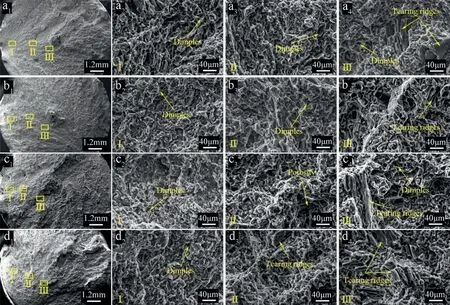
Fig.11.Tensile fracture of rod specimens produced with different processes:(a1-a4)A01–0.1 m/s-2.75 m/s-13.7 MPa;(b1-b4)A03–0.2 m/s-2.75 m/s-13.7 MPa;(c1-c4) A05–0.1 m/s-1.75 m/s-13.7 MPa;(d1-d4) A07–0.1 m/s-2.75 m/s-7.8 MPa.The first column is the overall morphology of the tensile fracture,and the second,third and fourth columns are the enlarged view of the I,II and III area.
5.Conclusion
In this study,we systematically studied the effects of different die-casting processes on the microstructure and mechanical properties of HPDC AE44 magnesium alloy by the combination of 2D observation and 3D reconstruction.Our results reveal that the size and quality of ESCs controlled by the low slow-shot speed in shot sleeve (ESCs growth time)and fast slow-shot speed into the die cavity (distribution of ESCs).The large shrinkage pores are always closed to ESCs.When the low slow-shot speed was increased from 0.1 m/s to be 0.2 m/s,the area percentage of ESCs and porosity volume are reduced about 11.5% and 50%,respectively.when the solidification pressure was increased from 7.8 MPa to be 13.7 MPa,the improvement of feeding ability can reduce 47%porosity.Tensile test shows that the fracture form of castings was mainly affected by the distribution of ESCs.More dimples appear in the surface layer with less ESCs,while cleavage fracture occurs in the center with more ESCs.Our results reveals that the mechanical properties of castings are inversely proportional to the quantity ESCs and porosity volume.The optimal mechanical properties of AE44 casting is obtained at the condition of When the low slow-shot speed of 0.2 m/s,fast slow-shot speed of 2.75 m/s and solidification pressure of 13.7 MPa.The tensile strength,yield strength and elongation of the castings are 253.7 MPa,161.0 MPa and 12.1%,respectively.
Acknowledgement
The experimental section was financially supported by the Fundamental Research Funds for the Central Universities(M22JBMC0060) and the National Natural Science Foundation of China(No.52175284),the State Key Lab of Advanced Metals and Materials (No.2021-ZD08).Thanks to the technical support of BL13W1 beamline in Shanghai Synchrotron Radiation Facility (SSRF).
杂志排行
Journal of Magnesium and Alloys的其它文章
- Corrosion behavior of composite coatings containing hydroxyapatite particles on Mg alloys by plasma electrolytic oxidation: A review
- Rational design,synthesis and prospect of biodegradable magnesium alloy vascular stents
- Antibacterial mechanism with consequent cytotoxicity of different reinforcements in biodegradable magnesium and zinc alloys: A review
- Preparation,interfacial regulation and strengthening of Mg/Al bimetal fabricated by compound casting: A review
- Pitting corrosion behavior and corrosion protection performance of cold sprayed double layered noble barrier coating on magnesium-based alloy in chloride containing solutions
- Designing strategy for corrosion-resistant Mg alloys based on film-free and film-covered models
